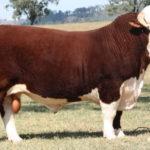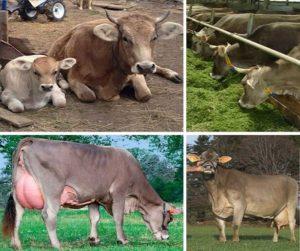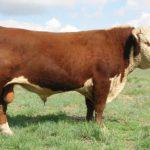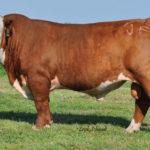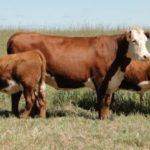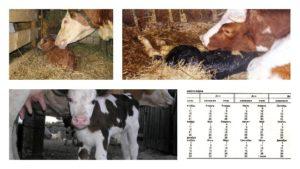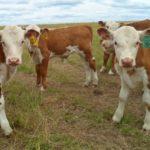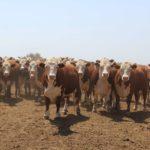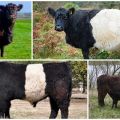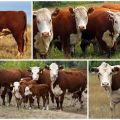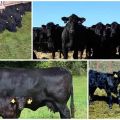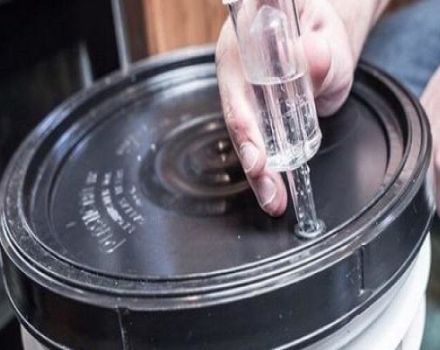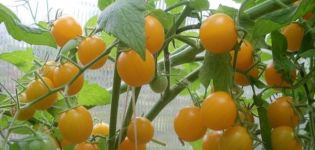Description and characteristics of Hereford cattle, maintenance and breeding
Cows of the Hereford breed were first bred in Britain, in the County of Herefordshire, after which, in 1817, cattle began to spread in the USA, Canada, Mexico. Today animals of this breed are bred in many countries of Europe, Asia and even on the Australian mainland. Hereford cows are hardy, unpretentious to the climate and keeping conditions, are famous for their excellent meat quality, large size and the ability to graze on pastures of different types.
Origin story
The origin of the Hereford breed was given from red cattle, which were bred in the west and south of England in the XVIII-XIX centuries, Hereford cows had a red color with light splashes. A cross between breeds, mainly with the appearance of shorthorn cattle, was bred specifically to increase the muscle mass of the animal and its pulling power. Also, breeders sought to obtain high quality meat. Benjamin Tomkins is considered the main creator of the Herefords.
Bulls and cows originally had a large body weight and reached 1500 kilograms in weight. Further, they tried to make the Hereford breed harmonious to obtain a good skin, high-quality and tasty marbled meat. Initially, the cattle had a light brown or gray color with small white blotches. Already at the end of the 19th century, the Herefords became famous for the white head, characteristic of the breed.
Description and characteristics of the Hereford cow
Hereford gobies and cows are hardy. They are grazed on a variety of pastures, they are unpretentious in food and can easily endure long distances. The breed has won worldwide recognition, and the hereford's name sign, the white head, remains after crossing with other types of cattle. The cows are very adaptable to climatic conditions, despite being bred in cool Britain.
Herefords have a lifespan of 15 to 18 years. Calves are born large, weigh from 25 to 33 kilograms, the average daily weight gain is 850-1250 grams. Maximum weight of adults:
- cows - 650-850 kilograms;
- bulls - 850-1300 kilograms.
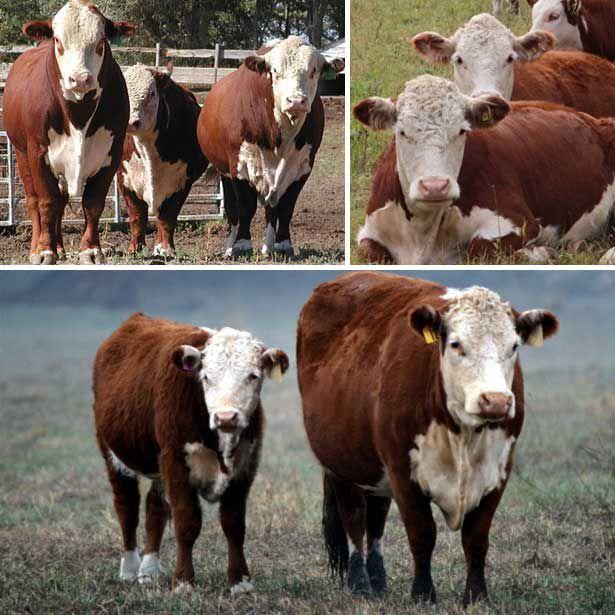
The constitution of Hereford cows is typically beef. The body is strong, barrel-shaped, with an intensely protruding dewlap. Herefords have a dark red skin, with white spots on the head, neck, belly and tips of tails. A broad, powerful torso is supported by strong, set legs.
Intra-breed types
Different types of Hereford cows are born through crossing with other varieties of cattle, bred specifically for subsequent living conditions. These include hot or cold climates, the need for traction work, obtaining exclusively meat or meat and dairy products.
Classical
The classic type of Hereford cattle is distinguished by a powerful body, a short neck with a large head, a thick skin, which is covered with thick wool in winter. The legs are strong and short, the udder is poorly developed. On the dark red body there are white markings on the belly, neck, head. The horns are light, may darken closer to the tips. Height at withers - 125 centimeters, chest girth - 170 centimeters, oblique body length - 150-153 centimeters.
Lumpy
The hornless type of Hereford was bred into a separate breed in 1889. Hornless bulls convey this characteristic, which denotes a lack of aggressive attitude towards service personnel. Hornless Hereford cows have excellent maternal and reproductive qualities.

The black
Black Herefords are derived from a Welsh breed raised in Britain for the sole purpose of obtaining meat. They had a large body mass, docile nature, high maternal instinct. The descendants of the Hereford breed passed black color, a large fluffy tail, high-quality marbled meat.
Positive and negative sides
The main advantage of Hereford cattle is unpretentiousness. Cows can graze on any pasture where there is fresh, juicy grass, clean water.
Bulls can gain weight even at -30 aboutC, while the diet does not require special combined feed.
Even in the absence of quality pastures, farmers get good offspring from Hereford females, who rarely have childbirth complications. Livestock is resistant to various diseases and gives weight gain even on poor grazing areas. Disadvantages of Herefords:
- periodic clearing of the dwarf gene;
- vaginal prolapse in cows at the birth of massive calves;
- lack of wool on the udder and occasional burns;
- eye diseases that develop with long grazing in the bright sun;
- small milk yield.
In general, animals are strong and resilient and do not require building warm barns. The only condition for keeping is good, dry bedding.
The nuances of maintenance and care
Herefords are hardy in all weather conditions, but can give poor weight gain with poor quality diet. Livestock reaches its maximum weight by autumn, by October it begins to be covered with a thick coat of wool. Even in winter, Herefords are allowed to walk outside, the percentage of fat in meat, however, becomes elevated. In severe frosts, it is important to keep livestock in a dry stall with dry, warm bedding.
Cows need cleanliness - every day you need to clean the wool from dirt, remove dry hair clumps, otherwise the animal will lose the natural process of thermoregulation.
Feeding
In the pasture, Hereford cows consume soft and coarse grasses, but when there is a shortage of succulent greens, it is important to introduce hay with salted barley into the diet. The menu should contain:
- corn silage;
- roughage;
- haylage;
- legumes;
- cereals;
- syrup;
- bone flour;
- phosphates.

Pregnant cows can keep hay in their diet even in summer and spring.Fattening gobies need calcined concentrates. A cow should feed the calves up to two months, but from two weeks of age they can eat hay. In the spring, calves need an increase in the volume of green mass, and in the fall - roughage of vegetable origin.
Breeding
Puberty in cows occurs at 18 months, the first calving is allowed at 30 months. The best time for calving is in the spring. It is imperative to involve a veterinarian to determine the ability of individual individuals to reproduce and check for pregnancy. Hereford cows rarely miscarry, only in cases of too early pregnancy screening (less than two months after coverage) and inappropriate heifer diet.
It is recommended that the calves are not kept in a separate stall, but together with their mothers. Daily replacement of the litter with a clean and dry one is required. Cows with calves on suction are fearful - loud noises and unexpected jerks shy away. During the fattening period, it is not recommended to let strangers into the barn, who can scare the cows.
Diseases and their treatment
Hereford cattle are distinguished by good health and longevity. Cases of umbilical hernia are common in calves, which makes young animals less likely to gain weight. In case of poor weight gain, these calves are discarded.
With a sharp change in conditions of detention, poor-quality care, in severe frosts, herefords develop bronchopulmonary diseases and digestive disorders. If the calves are purchased and brought from another place, it is important to provide a habitual diet, a warm dry room, free of drafts and high humidity. Only a veterinarian deals with the treatment of pathologies.
Distribution in the world
Today, Hereford cattle are common on all continents. They are bred not only in America, Brazil, South Africa, but also in Asia, Russia, Canada, Israel and Japan. On the territory of Russia, the Hereford breed is widespread in Bashkiria, Krasnoyarsk, Stavropol and Altai territories, in Siberia, on Sakhalin. The Hereford World Union is based in the UK, with the American Hereford Association being the next largest.
Hereford cattle are prized for their meat quality, endurance and body weight. The meat of the marbled variety is expensive, which justifies farmers' costs for feeding and keeping animals. Therefore, cows of this breed are bred worldwide.

